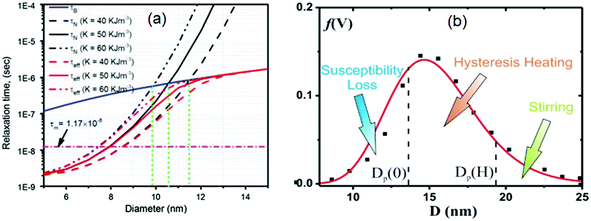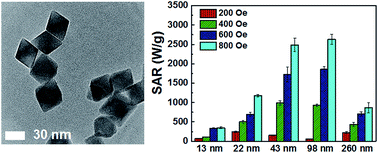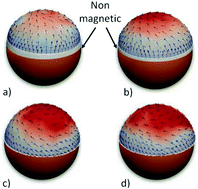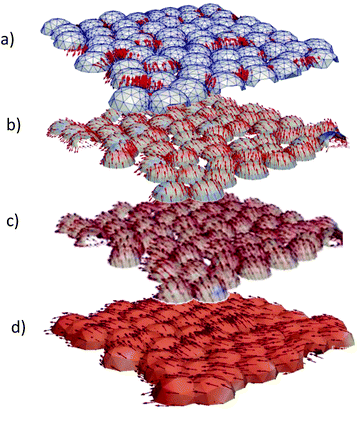Mixed Brownian alignment and Néel rotations in superparamagnetic iron oxide nanoparticle suspensions driven by an ac field.
Saqlain A. Shah, Daniel B. Reeves, R. Matthew Ferguson, John B. Weaver, and Kannan M. Krishnan
Phys. Rev. B 92, 094438 (2015)
A blog dedicated to recent publications in the field of Nanomagnetism. A selection of links to articles in the most important topics of magnetism of nanoparticles and nanostructures will appear here in a regular basis. Comments and discussion about the results will be welcome.
Friday 25 September 2015
Tuesday 22 September 2015
Phase transitions in spin ice of macroscopic dimensions
Thermodynamic phase transitions in a frustrated magnetic metamaterial.
L. Anghinolfi, H. Luetkens, J. Perron, M. G. Flokstra, O. Sendetskyi, A. Suter, T. Prokscha, P. M. Derlet, S. L. Lee & L. J. Heyderman
Nature Communications 6, 8278 (2015)
L. Anghinolfi, H. Luetkens, J. Perron, M. G. Flokstra, O. Sendetskyi, A. Suter, T. Prokscha, P. M. Derlet, S. L. Lee & L. J. Heyderman
Nature Communications 6, 8278 (2015)
Sunday 20 September 2015
Dynamically stabilized magnetic skyrmions
Dynamically stabilized magnetic skyrmions.
Y. Zhou, E. Iacocca, A. A. Awad, R. K. Dumas, F. C. Zhang, H. B. Braun and J. Åkerman
Nature Communications 6, 8193 (2015)
Y. Zhou, E. Iacocca, A. A. Awad, R. K. Dumas, F. C. Zhang, H. B. Braun and J. Åkerman
Nature Communications 6, 8193 (2015)
Friday 18 September 2015
From core/shell to hollow Fe/γ-Fe2O3 NPs
From core/shell to hollow Fe/γ-Fe2O3 nanoparticles: evolution of the magnetic behavior.
Z Nemati, H Khurshid, J Alonso, M H Phan, P Mukherjee and H Srikanth
Nanotechnology 26, 405705 (2015)
Z Nemati, H Khurshid, J Alonso, M H Phan, P Mukherjee and H Srikanth
Nanotechnology 26, 405705 (2015)
 |
| Bright-field TEM images of the 12 nm Fe/γ-Fe2O3 (a) core/shell, (b) core/void/shell, and (c) hollow nanoparticles |
Magnetic skyrmions beyond room temperature
A new class of chiral materials hosting magnetic skyrmions beyond room temperature.
Y. Tokunaga, X. Z. Yu, J. S. White, H. M. Rønnow, D. Morikawa, Y. Taguchi, Y. Tokura
Nature Communications 6, 7638 (2015)
Y. Tokunaga, X. Z. Yu, J. S. White, H. M. Rønnow, D. Morikawa, Y. Taguchi, Y. Tokura
Nature Communications 6, 7638 (2015)
 |
Lorentz transmission electron microscopy (LTEM) of skyrmion crystal. |
Neel-type skyrmion lattice
Néel-type skyrmion lattice with confined orientation in the polar magnetic semiconductor GaV4S8.
I. Kézsmárki, S. Bordács, P. Milde, E. Neuber, L. M. Eng, J. S. White, H. M. Rønnow, C. D. Dewhurst, M. Mochizuki, K. Yanai, H. Nakamura, D. Ehlers, V. Tsurkan & A. Loidl
Nature Materials 14, 1116 (2015)
I. Kézsmárki, S. Bordács, P. Milde, E. Neuber, L. M. Eng, J. S. White, H. M. Rønnow, C. D. Dewhurst, M. Mochizuki, K. Yanai, H. Nakamura, D. Ehlers, V. Tsurkan & A. Loidl
Nature Materials 14, 1116 (2015)
 |
| Spin patterns in the magnetic phases of GaV4S8. |
Thursday 17 September 2015
Giant moving vortex mass
Giant moving vortex mass in thick magnetic nanodots.
K. Y. Guslienko, G. N. Kakazei, J. Ding, X. M. Liu & A. O. Adeyeye
Scientific Reports 5, 13881 (2015)
K. Y. Guslienko, G. N. Kakazei, J. Ding, X. M. Liu & A. O. Adeyeye
Scientific Reports 5, 13881 (2015)
EB in spin glass/ferromagnet bilayers
Cooling field and temperature dependent exchange bias in spin glass/ferromagnet bilayers.
W. B. Rui, Y. Hu, A. Du, B. You, M. W. Xiao, W. Zhang, S. M. Zhou, J. Du
Scientific Reports 5, 13640 (2015)
W. B. Rui, Y. Hu, A. Du, B. You, M. W. Xiao, W. Zhang, S. M. Zhou, J. Du
Scientific Reports 5, 13640 (2015)
Tuesday 15 September 2015
Domain wall motion driven by spin torque
Influence of uniaxial anisotropy on domain wall motion driven by spin torque.
P. Chureemart, R. F. L. Evans, I. D'Amico, and R. W. Chantrell
Phys. Rev. B 92, 054434 (2015)
P. Chureemart, R. F. L. Evans, I. D'Amico, and R. W. Chantrell
Phys. Rev. B 92, 054434 (2015)
Skyrmions in MnSi Nanowires
Stabilized Skyrmion Phase Detected in MnSi Nanowires by Dynamic Cantilever Magnetometry
A. Mehlin, F. Xue, D. Liang, H. F. Du, M. J. Stolt, S. Jin, M. L. Tian, and M. Poggio
Nano Letters 15, 4839 (2015)
A. Mehlin, F. Xue, D. Liang, H. F. Du, M. J. Stolt, S. Jin, M. L. Tian, and M. Poggio
Nano Letters 15, 4839 (2015)
Hollow magnetite NPs for Li storage
Formation of Uniform Fe3O4 Hollow Spheres Organized by Ultrathin Nanosheets and Their Excellent Lithium Storage Properties.
Fei-Xiang Ma, Han Hu, Hao Bin Wu, Cheng-Yan Xu, Zhichuan Xu, Liang Zhen and Xiong Wen (David) Lou
Recent Advances in Higher-Order, Multimodal, Biomedical Imaging Agents
Recent Advances in Higher-Order, Multimodal, Biomedical Imaging Agents.
James Rieffel, Upendra Chitgupi and Jonathan F. Lovell
Small 35, 4445 (2015)
James Rieffel, Upendra Chitgupi and Jonathan F. Lovell
Small 35, 4445 (2015)
Size dependent magnetic hyperthermia
Size dependent magnetic hyperthermia of octahedral Fe3O4 nanoparticles.
Y. Lv, Y. Yang, J. Fang, H. Zhang, E. Peng, X. Liu, W. Xiao and J. Ding
RSC Advances 5, 76764 (2015)
Y. Lv, Y. Yang, J. Fang, H. Zhang, E. Peng, X. Liu, W. Xiao and J. Ding
RSC Advances 5, 76764 (2015)
Photo-fluorescent and magnetic properties of iron oxide nanoparticles: Review
Photo-fluorescent and magnetic properties of iron oxide nanoparticles for biomedical applications.
Donglu Shi, M. E. Sadat, Andrew W. Dunna and David B. Mast
Nanoscale 7, 8209 (2015)
Donglu Shi, M. E. Sadat, Andrew W. Dunna and David B. Mast
Nanoscale 7, 8209 (2015)
 |
| (a) Graphical representation of Brownian, Néel and effective relaxation times as a function of particle diameter for different values of anisotropy constant (K)4 and (b) representation of heating due to Néel and Brownian relaxations, and hysteresis loss |
Evolution of magnetism on a curved nano-surface - Nanoscale (RSC Publishing)
Evolution of magnetism on a curved nano-surface.
D. G. Merkel, D. Bessas, Z. Zolnai, R. Rüffer, A. I. Chumakov, H. Paddubrouskaya, C. Van Haesendonck, N. Nagy, A. L. Tóth and A. Deák
Nanoscale 7, 12878 (2015)Recent Advances in Biomedical Imaging Agents
Recent Advances in Higher-Order, Multimodal, Biomedical Imaging Agents.
James Rieffel, Upendra Chitgupi andJonathan F. Lovell
Small 11, 4445 (2015)
James Rieffel, Upendra Chitgupi andJonathan F. Lovell
Small 11, 4445 (2015)
γFe2O3@Au Magnetic Gold Nanoflowers for Efficient Cancer Theranostics
Rational Design and Synthesis of γFe2O3@Au Magnetic Gold Nanoflowers for Efficient Cancer Theranostics.
Jie Huang, Miao Guo, Hengte Ke, Cheng Zong, Bin Ren, Gang Liu, He Shen, Yufei Ma, Xiaoyong Wang, Hailu Zhang, Zongwu Deng, Huabing Chen and Zhijun Zhang
Labels:
Au,
Cancer,
Magh,
MRI,
Nanoparticles
EB in molecular layers
Exchange bias and room-temperature magnetic order in molecular layers.
Manuel Gruber, Fatima Ibrahim, Samy Boukari, Hironari Isshiki, Loïc Joly, Moritz Peter, Michał Studniarek, Victor Da Costa, Hashim Jabbar, Vincent Davesne, Ufuk Halisdemir, Jinjie Chen, Jacek Arabski, Edwige Otero, Fadi Choueikani, Kai Chen, Philippe Ohresser, Wulf Wulfhekel, Fabrice Scheurer, Wolfgang Weber, Mebarek Alouani, Eric Beaurepaire, Martin Bowen
Subscribe to:
Posts (Atom)












